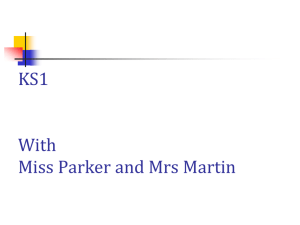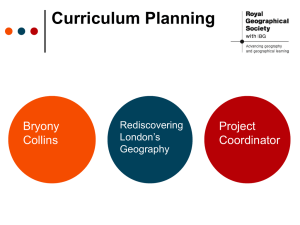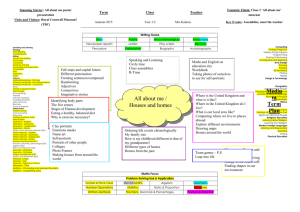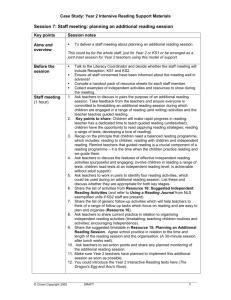Curriculum Management and Leadership for English Language
advertisement
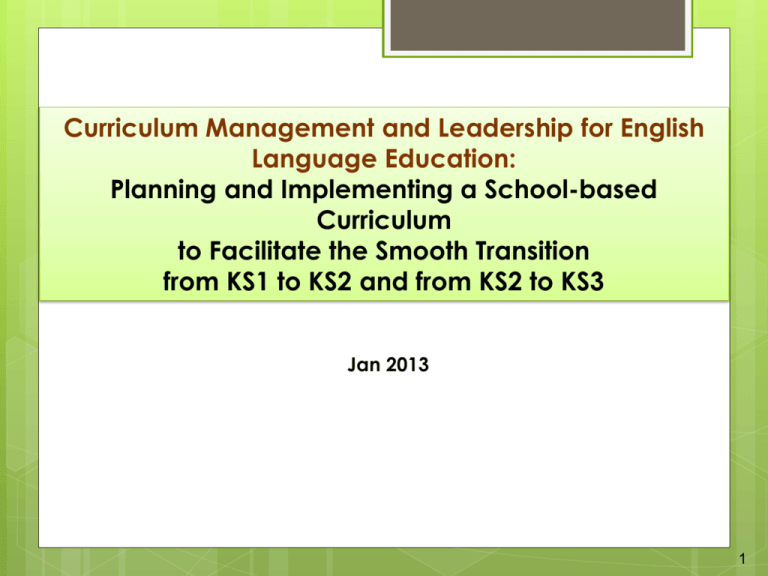
Curriculum Management and Leadership for English Language Education: Planning and Implementing a School-based Curriculum to Facilitate the Smooth Transition from KS1 to KS2 and from KS2 to KS3 Jan 2013 1 Roles of Curriculum Leaders Curriculum Leaders Curriculum Management implementing agreed policy managing learning and teaching effective deployment of staff and resources monitoring and evaluating performance and standards Leadership building a vision setting goals providing strategic directions developing policies effective team building 2 Components of a School-based English Language Curriculum in Primary Schools • About 40% of the lesson time • Closely linked to the learning and teaching in the GE Programme • About 60% of the lesson time English Language Curriculum Guide (Primary 1-6)(CDC, 2004) p.98 3 Key Emphases of the English Language Curriculum • Adopting a task-based approach • Strengthening a ‘reading to learn’ culture • Learning and teaching grammar in context • Developing vocabulary-building strategies • Promoting assessment for learning • Catering for learner diversity • Ensuring the smooth transition between key stages of learning (Interface) 4 School-based Curriculum Development Focuses for English Language Education Curriculum Development in the Short, Medium and Long Terms in Primary Schools English Language Curriculum Guide (Primary 1-6)(CDC, 2004) p.7 Conducting Holistic Planning Needs Analysis Action Planning Evaluation Refer to different sources of data (e.g. TSA data, internal assessment data, ESR and SSE findings) Conduct a critical review of the current situation Draw upon the needs analysis to identify the development focuses Set clear and specific objectives Decide on appropriate measures Ensure vertical and horizontal coordination Set a clear and practical schedule for implementation 7 Conducting Holistic Planning Needs Analysis Action Planning Evaluation Match with the objectives set Collect concrete data as evidence Use a good mix of qualitative and quantitative tools 8 Ensuring Vertical and Horizontal Coordination a balanced and adequate coverage of learning targets and objectives coherence in planning among teachers teaching the same year level and across year levels progression across year levels in learning, teaching and assessment 9 Transition From Key Stage 1 to Key Stage 2 and from Key Stage 2 to Key Stage 3 Leadership • What is our vision? • What is our goal? • What do our students need? What do we expect students to be able to perform by the end of KS1 and KS2? 10 HKDSE English Language Examination Graded approach adopted http://www.hkeaa.edu.hk/en/hkdse/hkdse_subj.html?A1&1&2_17 11 Strategies to Facilitate the Smooth Transition between Key Stages of Learning Leading curriculum planning, development and management Facilitating the interface between key stages of learning 12 Leading Curriculum Planning, Development and Management 1. Strengthen literacy development 2. Promote self-directed learning 3. Manage resources effectively 4. Enhance the communication among teachers 5. Enhance the professional development of teachers Curriculum Management 13 Strengthen Literacy Development Enhance the development of reading and writing skills Reading Workshops at KS2 • choice of texts • teaching strategies for reading • reading strategies and skills development School-based writing programme • connect reading with writing • provide opportunities to write for a variety of purposes • use of graphic organisers to develop and organise ideas 14 Teaching Strategies for Reading KS1 KS2 15 Development of Reading Skills from KS1 to KS2 KS1 KS2 1. Understand the basic conventions of written English Follow left to right directionality Use knowledge of letter-sound relationships to read aloud a variety of simple texts Use knowledge of basic letter-sound relationships to read out simple words Sight read common words Sight read a wide range of common words English Language Curriculum Guide (Primary 1-6)(CDC, 2004) pp.55-56 Development of Reading Skills from KS1 to KS2 KS1 KS2 3. Locate information and ideas Scan a text by looking at repeated words, words in bold, italics or capital letters Locate specific information in a short text in response to questions Scan a text by using strategies such as looking at headings and repeated phrases Identify details that support the gist or main ideas English Language Curriculum Guide (Primary 1-6)(CDC, 2004) pp.55-56 Development of Reading Skills from KS1 to KS2 KS1 KS2 2. Construct meaning from texts Guess the meaning of unknown words by using pictorial and contextual clues Identify key words for the main idea in a sentence Understand the information on the book cover and contents page Recognise the features of some common text types Work out the meaning of unknown words by using word association, visual clues, context & knowledge of the world Skim a text to obtain the main ideas Understand intention, attitudes and feelings conveyed in a text Understand the information provided on the book cover, index and glossary Recognise the features of a variety of text types English Language Curriculum Guide (Primary 1-6)(CDC, 2004) pp.55-56 18 Resource Package write for a variety of purposes and roles Nurturing Pupils’ Creative Thinking in the Upper Primary English Classroom 19 Use E-Learning to Promote Self-directed Learning PEER http://peer.edb.hkedcity.net/ 20 Use E-Learning to Promote Self-directed Learning EDB One-stop Portal http://minisite.proj.hkedcity.net/edbosp-eng/eng/home.html 21 Use E-Learning to Promote Self-directed Learning RTHK radio programme – Sunday Smile http://app3.rthk.org.hk/special/sundaysmile/radiostar/radiostar.php 22 Managing Resources 1. Human resources Appoint level coordinators to help with horizontal coordination Deploy the NET effectively 2. Learning and teaching resources Build up a resource bank with teaching plans, learning tasks and resource materials developed by teachers Make use of non-textbook resource materials to enhance learning Introduce EDB resource packages to teachers 3. Management of funds and grants Sustainable Capacity building Holistic and coherent Focused 23 Enhance the Communication among Teachers Regular collaborative meetings led by curriculum leaders Periodic reviews and sharing among all teachers Experienced teachers trying out new ideas and sharing with the less experienced teachers Identification and development of potential curriculum leaders 24 Enhancing the Professional Development of Teachers Provide a good model in classroom teaching and leadership Encourage and organise teachers to attend professional development programmes Encourage sharing of knowledge, ideas, experiences and good practices to build up a collaborative learning culture Collaborative lesson preparation Co-teaching Peer coaching Peer lesson observation Teacher reflection Regular sharing sessions 25 Professional Development Programmes 2012/2013 Available in Title (B) Sustaining the Curriculum and Assessment Reform Section Month Year 25 March 2013 ELE Developing Primary Pupils’ English Writing Skills through Strategic Scaffolding and Quality Feedback to Facilitate the Transition from KS2 to KS3 (Re-run) 25 Jan 16 & 23 Feb 2013 ELE Developing Primary Pupils' English Reading Strategies to Enhance their Learning Capacity to Facilitate the Transition from KS2 to KS3 (New) 18, 21 & 25 May 2013 ELE Using the Learning Progression Framework (LPF) to Enhance Learning, Teaching and Assessment for English Language at Primary Level (Re-run) 26 Enquiries English Language Education Section, CDI Room 1206, 12/F, Wu Chung House, 213 Queen’s Road East, Wan Chai, Hong Kong Ms Wendy TSANG Ms Iris CHAN Tel: 2892 6570 Tel: 2892 6414 Fax: 2834 7810 27

